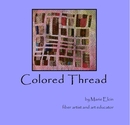This evening was the night for Color harmonies in Color theory class at Fleisher. ( I think this is the longest work day I've had in months). These mandala coloring book pages are a fantastic resource, as it allows students to just play with color and not have to worry about design.
monochromatic: using shades, tints, and tones of only one hue
Complementary: using colors opposite each other on the color wheel
Split-Complement: using one major hue and the 2 colors that lie adjacent to its complement
Analagous: using 3-4 colors that lie adjacent on the color wheel
Triadic: 3 equidistant colors around the color wheel (primaries, secondaries, 2 tertiary combos)
Tetradic: using 2 set of complementary pairs in a composition
In the image below, clockwise from top left, is analagous, secondary triad, complementary, and monochromatic.
Both Analagous Clockwise from top right, monochromatic, analagous, and complementary
Clockwise from top right, monochromatic, analagous, and complementary In zones from top to bottom, monochromatic, complementary, analagous, and triadic
In zones from top to bottom, monochromatic, complementary, analagous, and triadic

 Clockwise from top right, monochromatic, analagous, and complementary
Clockwise from top right, monochromatic, analagous, and complementary In zones from top to bottom, monochromatic, complementary, analagous, and triadic
In zones from top to bottom, monochromatic, complementary, analagous, and triadic
Everyone should start looking around themselves with new eyes, searching out all the color harmonies. These are just guidelines for choosing harmonious combinations, not rigid rules. You can put any colors you want together.






No comments:
Post a Comment